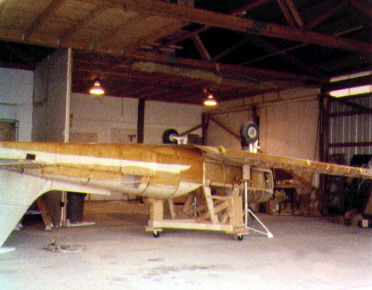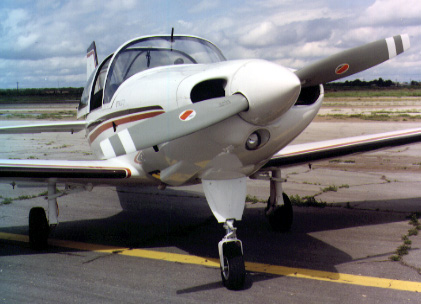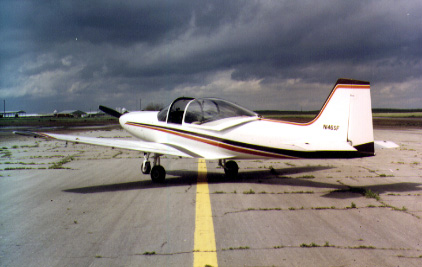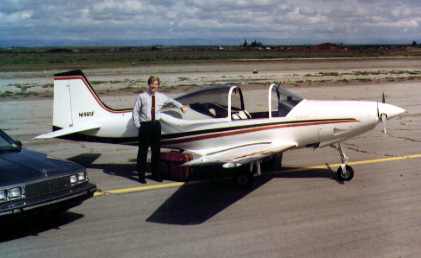First Flight:
Jim & Gail Martin
![]()
First Flight:
|
|
by Alfred Scott
This article appeared in the September 1988 issue of the Falco Builders Letter. |
Jim and Gail Martin's Falco flew for the first time on August 13th in Butler, Pennsylvania, making it the 17th Sequoia Falco to fly. Doing the honors was Robert Bassinger, a local instructor with lots of time in the CAP-10. The first flight lasted for about 45 minutes, all done with the gear down. With everything working well, Robert then took Jim up for a short ride.

I'm delighted to see builders like Jim Martin, Pawel Kwiecinski, Neville Langrick, and Richard Brown getting someone with more experience to do the first flight. It is an act of intelligence for a decision too often based on emotion. Jim Martin had done most of his flying in a Skyhawk and was not prepared for the Falco. It didn't hurt Jim's feelings that Robert Bassinger fell in love with the airplane. Jim says he is "like a kid with a toy. I can't get him out of it."
After the initial test flights were finished and confirmed that everything was working well, Robert checked Jim out in it.
"I'm glad he did," says Jim, who admits that he did not fly it well at first. He was accustomed to the slower approach speeds of the Skyhawk, and he initially let his speeds get too low. Then he would flare too high, as if he was landing in the Skyhawk. And once he managed to stall it before flaring. The left wing dropped sharply. Fortunately, they were only two feet off the ground.

Jim now has learned to fly the plane and feels comfortable landing the Falco, but it did take a period of adjustment. "I love the airplane," he says.
Jim reports that the Falco indicates about 150 knots at 2,500 to 3,500 feet at 75% power. The Falco has a 160 hp engine with a standard canopy. It weighed in at 1,231 lbs empty.
Everything on the Falco has worked well from the beginning. The only glitch has been a minor oil leak. Initially, they thought it was at the crankshaft oil seal, then in the propeller itself. The latest theory is that a loose fitting for the propeller oil pressure line might be the culprit. Jim has had the prop off three times, and this oil leak has been the only mechanical problem.
Jim said he thought we should install a stall warning system. He said his Falco stalls with absolutely no warning and with the left wing first. It turned out that he did not have the stall strips installed, and after reading to him what Mr. Frati said of anyone who did not have the stall strips installed, he said with a touch of chagrin that he was going to put the strips on right away.
Mr. Frati feels that the stall strips should be adjusted to tune the characteristics before they are permanently installed. I have advised many of you to go ahead and just put the things on the plane. I had always looked at the stall strips as turbulence generators to create the buffet on the tail and in that sense I could see little to be gained by playing with the position of the strips. I had been told that they should be tuned to the individual airplane, but concluded that this was probably one of those things where theory and practice seldom meet.
I doubt, for example, that the production Falcos were done this way, and those homebuilt Falcos which have had the stall strips just plastered on the front of the wing have all had admirable stall characteristics. And there is always the desire to paint everything before the first flight-everyone wants the stall strips to be painted as part of the wing.

So given the choice of installing a stall strip, painting the wing and go-fly-it, versus painting the wing and maybe putting a stall strip on later, I still say stick'em on the wing ahead of time. Mr. Frati is technically correct, but I'd rather see stall strips that have not been tuned than no stall strips at all-which is the more likely outcome. If you are going to fly the plane in primer, then just tape them in place and fiddle with them until you get things the way they should be.
In Jim Martin's case, the left wing stalls first. The first thing he should do is to put stall strips on the wing with duct tape and see how it flies. If the left wing still drops, then you want to induce the right wing to stall a little earlier, so you would raise the stall strip on the right wing. Then test it again.
Jim Martin bought the Falco plans in October 1980 and began construction shortly thereafter. He built the plane from kits, working on the plane for a while and then pulling off it for a spell. Jim's wife, Gail, kept her distance from the airplane, but as it took shape, she suddenly took an interest in it. Since then she has worked side-by-side with Jim on the plane. The "dynamic duo" is what she calls the team.
They took some time off to build a house-again both of them did it. Finally it was time to finish up the plane and like so many before them, the final stages took longer than expected. Jim had once offered the guess that they would be flying in October of last year, and here they are nearly a year later with the bird in the air.

About time, too, because Jim is retiring from the power company on September 30, and they are moving to Turlock, California, immediately after that.
The Falco is painted off white with metallic brown and metallic burnt orange stripes. It's painted in Imron and the dynamic duo did that, too. N146SF has a very nice interior that Gail did. The seats are upholstered in off-white shearling sheepskin, with salt-and-pepper carpet, and plush velour for the sides. The luggage compartment is upholstered like a seat, so everyone thinks the Falco is a 4-place airplane. There are no radios in the plane. That's something Jim is waiting for later. In the meantime he would rather cruise along without having to talk to anyone.
Jim had previously rebuilt a wrecked Grumman American, and most of his flying has been in humbler fowl than the Falco, and he is a bit nervous about flying such a valuable airplane. So he is willing to listen to offers for the Falco, though he's not going to give it away. As I write this, they have 12 hours on the plane. Jim says that "Everybody who flies the airplane falls in love with it." In the meantime, Jim and Gail are going to settle down in California, get things in order and spend a little time very carefully puttering around in their Falco.